A Paipo
Interview with Pete Sobels
March 14, 2015 - Mullumbimby (Australia)
Interview by Bob Green
Summary:
The
northern beaches of Sydney, Australia in the 1960s
were home to small groups of paipo riders. Pete Sobels was one of these
surfers, riding a board of his own design and proving it in local
waves and in Hawaii. He bought home a Hawaiian paipo board but
preferred to ride his "prototype" which has surprisingly contemporary
features.
|

Photo
by Bob Green.
|
|
1. You
mentioned you started riding a bellyboard after seeing Brian Hutchings.
I was thankful for Brian Hutchings for
introducing me to it (see Note 1 for more about
Brian Hutchings).
I asked some others from Avalon and they
didn't know
about Brian's bellyboards.
This
is going back a long time and Brian was probably an era in front of me
again. When I was 20, he would have been 30. He did live in Avalon for
a short while. He then moved and changed surf clubs to suit where he
lived. He was still a very fit man when he left. For quite a while, I
was the surf and belt champion in the Avalon Surf Club. He would wander
down and join the swims of a Sunday morning. He would be a 100 meters
in front of me at the finish. He was just so good. Even ten years older
than me. He was Australian surf and belt champion for so many years in
a row. He was a big, deep chested guy, tall and wide in the shoulder.
Brian Hutchings.
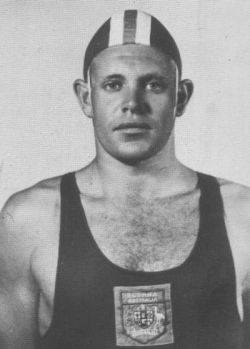
Source: Galton, Barry. (1984). Gladiators
of the surf: the Australian Surf Life Saving Championships, a history.
Frenchs Forest, N.S.W.: Reed.
It was interesting that he rode a narrower board than
you. He must have almost been bodysurfing?
That's why I went a little bit wider.
2. What were Brian Hutching's boards like and
how and where
did he ride them? When was this?
A little bit the same as the board shown below.
Brian's
board was narrower than this. It would have only been about 17-inches-
wide.
Pete Sobels and his board.
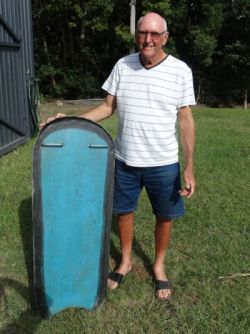
Photo by Bob Green.
Was it shorter?
No, it was the same length.
Did it have handles?
Yes, it did have handles. But it only had one fin. Just a standard
shaped fin.
A wooden fin?
Nothing too sophisticated back in 1962.
So, I decided to design this, then put twin fins on it. This is exactly
the way it was. This is the first board and the only one that I
designed and made.
3. This is an interesting board.
It is a prototype that worked. There is a very
original design for you. Back in 1962. This is the original board that
we started off with. It is 48 inches long, 20 inches wide and a
half-inch thick of 5-ply Coachwood marine.
It was taken out of a sheet of 8 x 4 foot, when the sheets were
manufactured in that size. You'd take out one and the next one, you'd
turn the board over and you'd get four out of one sheet. It is 20
inches at
the widest point. I had so much fun on that board.
Pete's board
twin fin paipo board is 48 x 20 inches and 17 inches near the tail.
|
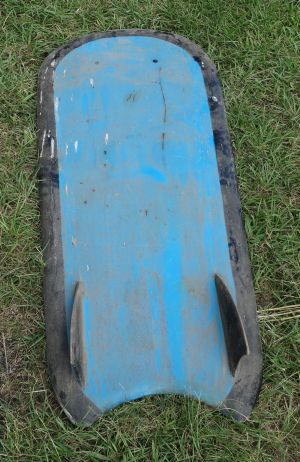
|
|
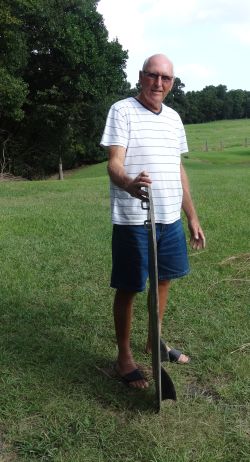
|
Photos by Bob Green.
So did you copy your board from Brian's?
No, his was narrower and rounded (at nose) and it went down to a
narrower tail. It was fairly narrow. I decided to just make it a bit
wider. When you make it wider it is easier to cut it down, isn't it?
But
this went so well that I just stuck to it.
And the fins are angled. Why did you angle the fins?
I have no real idea why I angled the fins. It just seemed like a good
idea at the time. (Editor's Note: The fins appear to be both toed-in
and canted which was very unusual in the early-1960s, as were
twin-fins.)
How are the fins put in?
Screwed in and then it is laminated (at the fin base). This veneer of
resin is pretty thick.
Handles and
fin-setup.
|
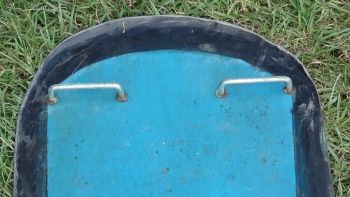
|
|
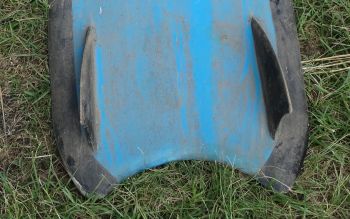
|
Photos by Bob Green.
Is there fiberglass on the bottom? It's quite heavy.
Just resin on the top and bottom. This shape here (the tail) is a
fairly
standard shape these days. These were the things that everyone,
including Paul Gannon and Dave Flatt,
myself and maybe three or four others rode (see Note 2).
I ended up making about a
dozen of these things, for the cost of the materials.
If you've spoken to Paul Gannon, he would have ridden one of my boards
or close to it. Everybody used to copy one another. He used to live
just up the street from the surf club. Those kids, in those days, I was
driving my car down there so I was 18, 19. Those kids were 12, 13, 14.
They were the next generation under me.
4. So where did you surf the board?
Everywhere. Anywhere from Fairy Bower to North
Palm Beach. Wherever the
swell was.
How long did you ride the board for?
I'd still ride it today if I felt like it because you can ride that in
a big swell. All you do is duck dive, because there is no resistance,
come up and keep on kicking. It was so easy to handle and whenever you
lost the wave or had a wipeout or something, the board wouldn't be very
far from you. That was the other advantage it would pop up right beside
you. It could have been 10 or 12 foot. You didn't need leg ropes or
hand
straps, or anything.
That was the advantage at Little Avalon because whenever you got wiped
out over there, you'd grab your board because it popped beside you and
wouldn't get washed up on the rocks. It was primarily a body surfing
spot in those days. You'd never get boards out there. Because the
boards in those days were the long planks. It was very steep and very
quick. It would suck up. You'd have to be right on there, right in the
right position. These things were the go.
(Below left)
The Little
Avalon take-off and the old surf club in the background. "That's why
you need those plywood boards because if you lost it, it was straight
onto the rocks." (Below right) Avalon Beach and Little Avalon in the
background.
|
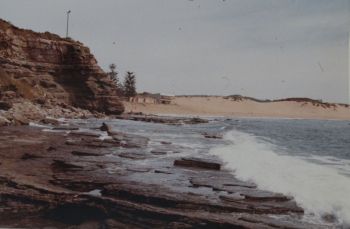
|
|
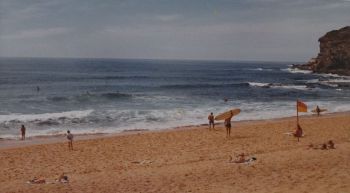
|
Photos courtesy of Pete Sobels.
You surfed Little Avalon from 1962?
Right through. I did something like 18 years straight of active service
being a lifesaver.
So you kept riding this up until about 1980?
Yes, round about that.
So when was the last time you rode it?
It would have been just before I moved the timberyard from Leichardt up
to Ballina. I had a timberyard in Ballina, that was 1979, 1980. I
reckon
that was the last time. It's been up in the shed ever since. Nostalgia.
5. What about this finless paipo board? When was this
board made?
I went to Hawaii in 1964, and brought it back
with me.
So this board was bought in Hawaii? Did you buy it in
a shop?
No, I think I bought it from the place that he actually made it in the
backyard. It was recommended so I went around and saw him. He had the
mold. They're not a flat board. You see they're molded on the side
there and they have a dish in here. He used to put the layers of
veneers and glue it all together.
There was a guy, Val Valentine, at Sunset Beach, who
used to make boards in a mold. His boards used to have a logo.
It used to have a logo down the bottom underneath all this.
It wasn't a Paipo Nui?
Yes. It did have the brand down there. I got to it with the grinder and
took a lot of weight out it, out of here. I keep on modifying things.
It was very heavy board. But that's why they were so good in big surf.
They could skip along like a stone.
Exactly. It didn't have this flaring on it at the nose. That's the
original line along here.
Pete Sobel's
Paipo
Nui with extra nose lift. The extra lift was added not for surfing, but
much later so his
kids could wake board behind their speed boat.
|
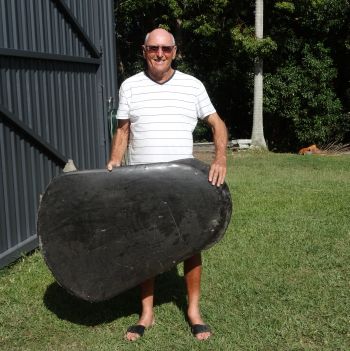
|
|
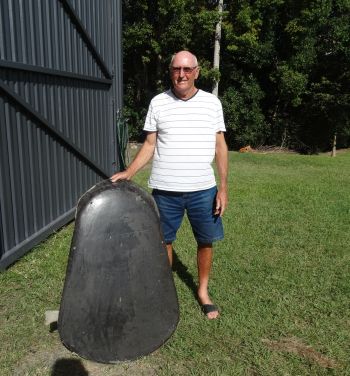
|
Photos by Bob Green.
6. So did you ride the Paipo Nui board at the same time
as you rode the board that you made?
Not as much. I didn't really cotton onto the
paipo board.
You need a launching pad with these boards.
They're so slow to take off with these things.
Did you ride the Paipo Nui in Hawaii?
Yeah I had a crack at a few, Sunset, Haleiwa. Haleiwa was pretty good
but it was a long way offshore.
I took my board to Hawaii and brought back a paipo. I went away with
one board and came back with two. I surfed Haleiwa. Sunset was too
busy. This was the era of Buzzy Trent and all those big names.
7. What technique was involved in riding your board?
People think you just lie down.
Basically that's what you did. There wasn't
much to it.
How did you turn?
It was the weight on your elbows. It wasn't anything really way out
riding. It was take the biggest wave you could and see if you could
make
it.
So what was a good ride? Was it along ride?
The hairiest ride that you could get. The biggest, the meanest bastard.
So it was about big waves
Yeah, we used to chase them all over the place.
I see the handles are screwed in as well and resined.
Did they do anything else besides holding onto them so you didn't lose
the board?
No, that was the main function of them. It was control so you didn't
have your hands over the rails.
Would you ride with your hands on the rails?
Sometimes you'd have your arm out. It was a bit of this, a mishmash.
With the handles you are on your elbows.
Captain Ron Ware, John
Tueland and Pete Sobels on the inside, off Avalon pool, ca. 1965-66.
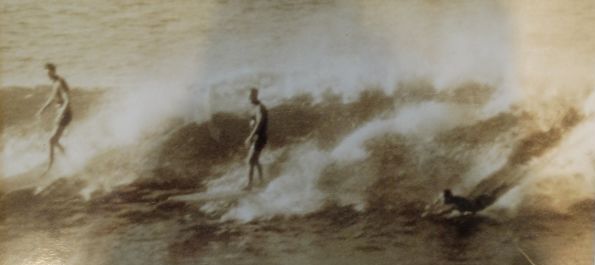
Photo courtesy of Pete Sobels.
8. What sort of flippers did you have?
The old Pacific Surfer brand. Each person liked
a different type of flipper on their feet. They suited my feet so I was
happy with those.
9. Did you surf with Dave Sams much?
Yes, quite a lot. He'd always be out at Newport
reef. The only time you'd surf Newport reef, the only time it would
work would be in a big south swell. So I'd strike him out there all the
time. It was just like bees to a honeypot.
It's interesting. Didn't Dave have a completely
different type of board than yours?
He was into surfing boards, surfboards.
Here's some photos of his boards (see the Dave Sams
paipo interview).
I never saw him ride that sort of board.
Here is a photo of you surfing that Dave sent me.
That's Newport Pool. We used to surf there all the time. I've got a
photo in my office on that board I'll show you.
(Below left)
Pete paipo surfing at Newport
Pool, ca. 1966. (Below right) Pete at Avalon.
|
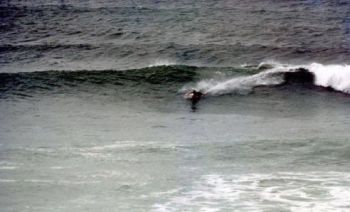
|
|
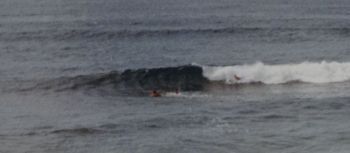
|
Photos courtesy of Dave Sams.
10. So where do you reckon was the best surf you ever
had on this board was?
Most probably Newport reef and also Little
Avalon. I've actually caught waves from the takeoff at Little Avalon to
the swimming pool.
How far is that?
200 meters.
These would build up a bit of momentum?
Oh yeah, they go.
So was it largely straight line speed or could you
turn?
Basically it was just a matter of making the section.
Fancy turns?
No, no.
Tube rides?
You'd try to. It was nothing fancy in those days.
So what was the biggest wave you rode on your
board?
Around Sydney your biggest wave was around 15 feet. Fifteen feet is a
huge
wave. Long reef produced a huge wave. I reckon my biggest wave, about
10 feet. The thing is, the face can get very lumpy, bumpy, and on these
things it doesn't take much to hit it and then you're airborne and you
don't know whats going to happen.
A downside of these boards in big conditions is that
it can be difficult to paddle against the strong sweep we get on the
east coast.
I
got stuck out at Crescent Head one day in that sort of situation.
Huge swell. When it gets big and you get that sweep going, it doesn't
matter how far out you go you get stuck out there and that's what
happened to us this day, me and John Lynch. He was bodysurfing and I
was riding this. We ended up going about one mile up the beach before
we got out because of this sweep factor. We had people watching us—they
thought we were gone. It was only because we were so fit that we
got out of it.
The guys who rode these thin boards were really fit
and good bodysurfers.
All those guys looked after themselves. They swam—it was a matter of
lifestyle. You just carry on being fit.
Pete Sobels, "That's when
I had hair.
That's the board down in the shed. That's a big day at Avalon beach.
You see whitewater from headland-to-headland. About 8 feet I
suppose—there
wasn't much of a ride on it. You take an angle takeoff and take the
drop
and flick off."
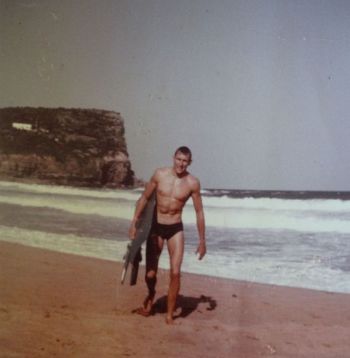
Photo courtesy of Pete Sobels.
11. You'd know that feeling of flying over sections with
very little drag?
Effortless. It was just really, really nice to
have a good clean wave, a fast wave and just make the section. You just
do a duck dive and the white water would go over the top of you, you
pop out the back and paddle out for the next one. It was so easy. It
worked for many, many years.
Why did you stop riding the board?
Change of lifestyle. You get married, you have kids. Then you go
fishing. I went fishing for ten or fifteen years around the rocks at
the
hole in the wall at Avalon. I got into wave skis. Then you lose contact
with things. I did patrols, but in between which might be three or four
weeks you wouldn't go back down to the surf club. I'd be with the
family.
Pete on a wave. In the
foreground is a surfer with a surfoplane with handles.
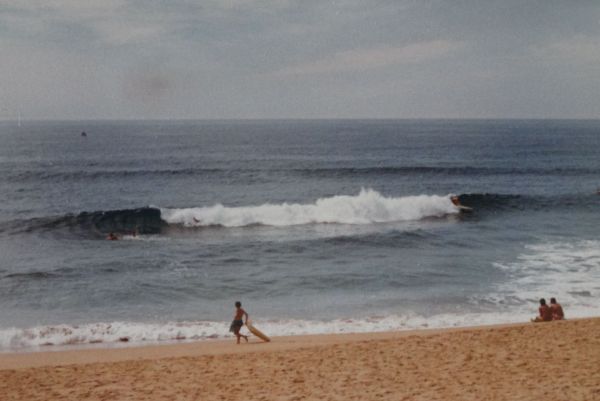
Photo courtesy of Pete Sobels.
|
Note 1:
Below is a tribute to Brian Hutchings, Surf Life Saving Australia Hall
of Fame member and Bondi Surf Bathers Life Saving Club member (http://bondisurfclub.com/history/hall-of-fame-members).
"Life
Member Brian “Hutcho” Hutchings was arguably Bondi greatest
competitor. He defeated legends of the surf including, Manly’s Max
Riddington, North Cronulla’s Bruce Bourke, North Bondi’s Gary Winram
and Freshwaters Barry Lumsdaine. In his first season in senior
competition he won three senior surf races from three starts. For his
efforts he was rewarded with selection in the Australian Team to meet
New Zealand at the Royal Surf Carnival held at Bondi in February 1954.
He won the Australian Open Surf Race Championship in 1954, 1956 and
1959 and won silver in 1960 and bronze in 1958. He also won the
Australian Open Belt Race Championship in 1961 and 1963".
TRIBUTE TO
MR BRIAN HUTCHINGS: NSW LEGISLATIVE ASSEMBLY. Wednesday 25
May 2005
Mr GEOFF
CORRIGAN (Camden) [6.13 p.m.]: Today I pay tribute to the late
Brian Hutchings, a champion surf lifesaver and a champion bloke.
Growing up on the Central Coast of New South Wales, as I did, if you
went to the beach you usually ended up as a lifesaver or a boardie, and
rarely was there a crossover. It was my good fortune from the ages of
16 to 23 to be a surf lifesaver at what I still consider the best beach
in Australia, Soldiers Beach. I was a fairly good still water swimmer
and considered myself to be a good surf swimmer until I met a fellow
named Brian Hutchings. Brian could have been the man on whom "Chesty
Bond" was modeled. He was a barrel-chested man with a wonderful
languid swimming stroke. He moved through the surf with the same ease
that Ian Thorpe or Don Schollander move through the swimming pool. He
was a champion in the big surf. At a function held for Brian, Harry
Nightingale, a legend at Bondi, said when proposing a toast, "He is one
of the greatest surf men of all time."
Brian helped
me to become a much better body surfer and, therefore, a
better competitor and lifesaver. Time prevents me from going through
the hints and techniques he gave me, but I can inform the House that he
always helped any aspiring surf lifesaver with the same advice. Brian
joined the Soldiers Beach Surf Life Saving Club in the early 1970s.
From the 1974 annual report I see he was the water coach that year. I
was the beach coach. When I first met him I did not know about his
outstanding performances in surf lifesaving. Merely reading his record
in the annals of the Bondi Beach Surf Bathers Life Saving Club or
Soldiers Beach Surf Live Saving Club cannot give you an idea of the
help and inspiration he provided to generations of surfers.
Brian
tragically died on 5 May 2005, aged 69, after suffering a massive
heart attack whilst competing in a longboard contest at Rainbow Bay on
the Tweed Coast. Brian was a legend at Bondi Surf Bathers Life Saving
Club. Amongst his achievements was winning the Australian Open Surf
Race Championship in 1954, 1956 and 1959, finishing second in 1960 and
third in 1958. He also won the Australian Open Belt Race Championship
in 1961 and 1963. The details of these wins and the wonderful surfers
that he competed against—such as Max Riddington, Hayden Kenny, Jon
Donohoe and Stevie Wilkes—can be found on the website of Bondi Surf
Bathers Life Saving Club. I commend it as compulsive reading.
When Brian
was competing it was truly a golden age of surf lifesaving
and huge crowds would attend. Indeed, it was estimated that the test
match against New Zealand at Bondi in 1954 drew a crowd of 150,000,
with each one cheering local hero Brian Hutchings. Brian was a humble
man. Despite his long involvement with the sport he described as "a
great way of life", he was not particularly comfortable with his
elevation to the Surf Life Saving Australia Hall of Fame in March 2004.
"I'm a bit embarrassed by it actually", he said last year, "There are a
lot of people in surf who do a lot more than me, but I was lucky to
have been involved as a competitor where my profile was higher". I
refer to the Bondi Surfer, volume 2, no. 10, May 1954, when he competed
before Her Majesty Queen Elizabeth II and His Royal Highness the Duke
of Edinburgh:
An Australian representative before the Royal Couple, one Australian,
two State and a Metropolitan Championship, as well as a number of surf
races and a coming trip to South Africa as an Australian representative
has not made the slightest difference to the lad himself and it is very
pleasing to see him retain his quiet, friendly personality. He is
really a very fine club man, ready at all times to take part on behalf
of the Club without any thought of personal consideration.
That was the
Brian I knew, a man who was always prepared to help the
young surf lifesavers, a humble man and a wonderful surfer. After I
ceased active surf lifesaving I would often see Brian, his wife, Pam,
and sons, Greg and Tod, at Soldiers Beach when I was up on the Central
Coast visiting my mum and dad. He always had time for a chat and I
would take time to watch him swim those big waves, for which he was
renown. He was a fearless and wonderful surfer. Brian was a champion
surfer, a champion father and a champion teacher of those who wanted to
learn more. Though he left us far too early, I cannot help but think
that he would have been happy to spend his final time in the surf in
competition. I read in a Sunday Telegraph article that Brian's ashes
were scattered on the surf at Bondi the week before last. I can think
of no more appropriate spot for his final resting place.
Note 2: See the paipo Interview
with Paul Gannon on MyPaipoBoards.org. |
|